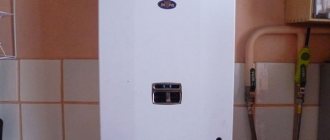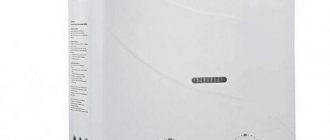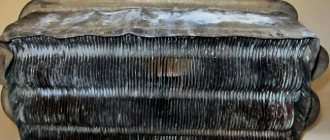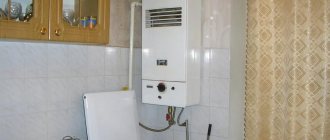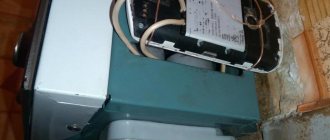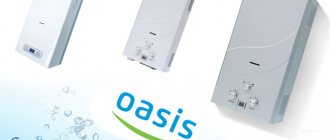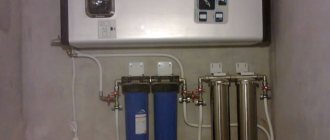The easiest way to explain this issue is economically. A double-circuit boiler turns out to be much more expensive due to a dedicated second heating system. A boiler is on average cheaper, but the water collected in the tank takes a very long time to heat up, and tanks with turbo mode are very expensive.
Speakers built into ventilation shafts are a cheaper option than turbocharged ones, but are not always of adequate quality. In addition, in a private house, by and large, you can design the exhaust any way you like, and with all other characteristics being equal, a closed chamber will always be cleaner.
[contents]
Advantages of a water heater with a turbine and a closed chamber:
- exhaust purity ensured by the combustion of hydrocarbons in a confined space, without potential leaks;
- fireproof separate exhaust;
- accelerated heating thanks to the turbine;
- as a rule, an intelligent ignition system in more expensive models. Fine temperature control accurate to the degree;
- Electric ignition by default is due to the technical features of the turbine.
This design also has several disadvantages:
- the fundamental problem is some drainage of water. Despite the more refined mechanism, some volume still has to be released until the desired temperature appears;
- noisiness. Due to additional mechanical structures, even expensive solutions on average are often noisier by almost a dozen decibels;
- problems in building regulations regarding the chimney issue. In apartment buildings, sometimes it is impossible to implement it independently, and it is strictly prohibited to include a turbocharged column in a common ventilation hood;
- dependence on mains electricity. Both ignition, temperature control sensors, and indicators in such water heaters operate “from an outlet”; completely mechanical systems do not exist.
- the actual price. With the exception of some localized Chinese manufacturers, the cost of closed chamber speakers is very high.
Principles for selecting a turbo dispenser
Selection of a turbo heater
The range of gas water heaters with turbo mode on the Russian market is frankly small. For many years, one model from Bosch dominated, which was frankly not the best in its mechanical characteristics, a little later an option from Ariston of the “Marco Polo” series was added, both options were practically the only choice in the CIS.
Now the situation has leveled out somewhat, but below we will consider turbocharged speakers from different manufacturers en masse. This is due to the fact that even in 2022 only the largest manufacturers have a full line of heaters with a closed chamber.
The second reason, as already mentioned, lies in the fairly high price. We neglect everything that is more expensive than a thousand dollars (Bosch, for example, has several models that are much more expensive). From a practicality point of view and taking into account the Russian climate, it is better to buy a double-circuit boiler with a heating function for almost the same amount, and the lack of waiting for heating is more than compensated by the possibility of using full-fledged independent heating.
Water heating systems based on the combustion of hydrocarbons depend primarily on the pressure of the gas mixture. If we are talking about a propane-butane system powered from a cylinder, an appropriate reducer is usually installed. Turbocharged dispensers with the ability to connect cylinders are marked separately. If the water dispenser is traditionally connected to the gas main, then the end user has no influence on anything in this regard.
The second necessary parameter is water pressure. In most of our systems, according to all standards, it is within 0.15 bar. But in the event of a serious gust, the design of the speakers usually includes the ability to survive a water hammer with a force of up to 12-15 bar.
It should be noted that geysers of turbo systems often become victims of the “advanced” system. In cases of “intelligent” flame control, a sensor can be installed to monitor the water pressure and adjust the burner accordingly. The problem is that such sensors in many mid-price models are incredibly capricious, which is why either an icy stream or hot boiling water periodically flows from the column.
The performance of the column is calculated by how many liters are heated per minute. In the case of turbocharged dispensers, this parameter directly depends solely on the power of the blower, which provides the flow, because the diameters of the supply pipes are standardized. The recommended performance of the column for various household needs can be briefly described by the following diagram:
Column diagram
On average, it is assumed that one water supply point is a mixer, which consumes about 7 liters of water per minute. The picture as a whole is universal for both simple open-chamber speakers and turbo systems.
The issue of igniting the device is resolved relatively simply. Any water heating equipment can be started in the following ways:
- manually, with open fire, primarily with matches. The simplest option, but it is also the most fire hazardous. In addition, the mechanical structure breaks down;
- piezoelectric element, activated by a separate button.
- Electric ignition. The best possible option.
Turbocharged speakers use the latter option.
Advice. All other things being equal, choose a simpler design. If there is no significant increase in performance and smoothness of heating control, there is little point in additional sensors, they cost a large amount, and the fault tolerance is much lower. There are also very reliable technically advanced models, but they are much more expensive.
How do they work
The principle of operation of chimneyless water heaters is the same as that of conventional exhaust devices. They differ only in their more advanced design and level of automation.
Work algorithm:
- The normal state is standby mode. The device is waiting for a signal to start. Ignition begins at the command of the control system.
- When the tap is opened, the flow sensor is triggered. The gas valve opens thanks to the membrane of the water unit. Gas begins to flow through the open path to the burner device.
- Near the burner there are electrodes, which, responding to the controller’s command, produce a spark discharge - the gas is ignited. The flame is detected by a corresponding sensor - it sends information to the control unit, which stops the sparking process. At the same time, the turbine is started, pumping air.
- The fire, regulated by the controller, heats the water to a temperature set by the user - this process is also monitored by a special sensor. When the liquid is heated to the desired degree, the burner power is reduced (modulation) or several stages of the burner are switched off.
- When the hot water tap is closed, the gas stops flowing, the fire goes out - the cycle is complete.
Roda JSD20-T1
Roda JSD20-T1 [gallery2 link=»file» size=»full» ids=»15358,15359,15360"] A
popular middle column in catalogs from a well-known German manufacturer of household appliances. The average price in Russian online catalogs fluctuates around 11-12 thousand roubles.
Characteristics
| Technical Parameter | Implementation |
| Type of equipment | Flow-through geyser |
| Ignition type | electrician |
| Water consumption | 10 liters |
| Design features of the model | There is no way to connect to a cylinder |
| Control | Mechanical round power selector and LCD temperature indicator |
The overall product rating is 4.5. An excellent model, affordable, reliable, and very easy to operate. There is one significant drawback - it does not work on propane.
Recommendations when choosing
It is impossible to give any definite advice regarding the place of purchase of a gas appliance. You need to focus on stores known for quality of service, a varied assortment, and the presence of decent models.
Specialized plumbing and heating equipment stores offer a large selection of products, the characteristics of which can be seen in person and the appearance of the column can be assessed. Purchasing through an online store also has its advantages - the ability to exchange and return goods within two weeks without specifying the reason, a huge selection, ordering a rare model, reading reviews from other customers.
The Neva gas water heater with a closed combustion chamber is popular. This equipment is characterized by flow-through heating of water, the use of liquefied gas, and the ability to connect to bottled gas. Based on operating practice, it is known that using this device you can obtain 6 liters of hot water per minute. The flow column is equipped with sensors and timers that are responsible for the high-quality functioning of the device. Has a power of 9 kW.
When purchasing a gas water heater, first of all, you should make sure that there is a decent security system for comfortable use of the equipment. It must be equipped with sensors that monitor flame, overheating and backdraft of the chimney. You can choose any ignition option based on your preferences and wishes.
Lemax Turbo-24
Lemax Turbo-24
Also a well-known model from catalogs. The production is a Russian-Chinese joint venture, thanks to which the electronics are quite decent and the price is affordable - from 15 thousand rubles.
Characteristics
| Technical Parameter | Implementation |
| Type of equipment | Flow-through geyser |
| Ignition type | electrician |
| Water consumption | 12 liters |
| Design features of the model | Asymmetrical design, good RCD |
| Control | Sensors and a small screen with indicators and numbers |
Rating - 4. Good performance, adapted to Russian networks, but assembly is not always perfect.
Models with capacity up to 8 l/min
#1
Bosch WTD 12 AME
Reliable and powerful model from a manufacturer with an impeccable reputation
Expert rating:98/ 100
The modification of the Therm 4000 S series from the Bosch brand is distinguished by its standard dimensions, thanks to which the column can be placed even in a small room.
Despite its relatively modest performance, a water heater designed for one water intake point is quite powerful. Therefore, with it, the water almost instantly heats up to 60 degrees. It is also convenient that the Bosch Bosch WTD 12 AME model operates without interruption even with low inlet water pressure: the unit only needs 0.1 atm to start the heating process.
Gas consumption is also pleasing: this column consumes 2.1 cubic meters. m/h when connected to a common gas pipeline and 1.7 cubic meters. m/h when operating from a cylinder. Fuel saving is also facilitated by electric ignition, which turns on the burner only when the tap is opened.
Specifications:
- power – 20.8 kW;
- productivity – 8 l/min;
- minimum/maximum water pressure – 0.1/12 atm;
- control type – electronic;
- dimensions (WxHxD, mm) – 300x568x170.
Bosch WTD 12 AME can be called the optimal model for homes with low pressure in the water supply. And working on liquefied gas from a cylinder allows you to use the equipment even where gasification has not yet been carried out.
Advantages
- Economical
- Control of temperature fluctuations down to 1 degree
- Excellent power
- Heating water up to 60 degrees
- Trouble-free operation at low water pressure
Flaws
- Price
#2
Oasis B-12W
Compact and inexpensive speaker for very small kitchens
Expert rating:96/ 100
The budget speaker from Oasis has low performance, but fully compensates for it with its dimensions and low weight of 4.2 kg. It is one of the most compact in height and depth, making it suitable for small rooms or even niches. Electric ignition is carried out using batteries, which makes the device operate completely independent of the mains.
A bonus is the operation under conditions of low pressure in the gas pipeline. To start heating the model normally, a pressure of 0.02 MPa is sufficient. At the same time, the column maintains high efficiency - more than 90%. The manufacturer provides the ability to limit the maximum water heating temperature, which allows you to save gas.
Specifications:
- power – 11 kW;
- productivity – 5 l/min;
- minimum/maximum water pressure – 0.2/8 atm;
- control type – mechanical;
- Dimensions (WxHxD, mm) – 290x370x120.
Oasis B-12W is installed vertically with bottom connection. The multi-level security system makes operation as reliable as possible, which is especially important for families with children.
Advantages
- Compact and light weight
- Undemanding to pressure in the gas pipeline
- High efficiency
- Reasonable price
- Availability of display and thermometer
Flaws
- The first malfunctions may appear after a couple of years of operation.
WERT 10LT white
WERT 10LT white
An ultra-budget option for the home, it costs only 8 thousand rubles, which is cheaper than many speakers with an open chamber.
Characteristics
| Technical Parameter | Implementation |
| Type of equipment | Flow-through geyser |
| Ignition type | electrician |
| Water consumption | 10 liters |
| Design features of the model | Front heat dissipation grille |
| Control | LCD indicator, two mechanical round selectors |
Rating - 3. Chinese assembly in the worst sense of the word. The turbine is noisy, breaks down, and periodically produces the wrong water temperature. But it's cheap.
The principle of operation of a gas boiler
Operating principle of a condensing boiler
The operation scheme of a gas boiler consists of the following stages.
First of all, the automation is turned on, which is set in a certain mode. It not only turns the boiler on or off, but also controls the specified parameters of the coolant.
The coolant itself, usually tap water, passes inside the heat exchanger, which is heated by the fire of a gas burner. The coolant is moved by a circulation pump.
If some parameters of the coolant, namely temperature and volume, change during the operation of the heating system, the automation will either turn off the boiler or turn on diagnostics that will adjust all the parameters of the coolant to the specified ones.
For example, if the volume of water in the system decreases due to overheating, the automation will open the cold water supply valve into the system. If the coolant temperature rises sharply, the gas supply to the burner will decrease. And vice versa - if the temperature drops, the gas pressure rises.
Currently, manufacturers offer a choice of a single-circuit gas boiler or a double-circuit wall-mounted gas boiler. What is the difference? Let's explain it in a simple way.
Single-circuit boilers are intended only for heating, and double-circuit boilers are intended for heating and supplying hot water. Of course, the second option is more comfortable. After all, there is no need to install additional equipment that would separately heat water for domestic needs. By the way, this could be a gas water heater or an electric boiler.
Vatti MR11-N
Vatti MR11-N
Miniature and very low-power speaker. Prices - from 5 thousand rubles.
Characteristics
| Technical Parameter | Implementation |
| Type of equipment | Flow-through geyser |
| Ignition type | Fully electric |
| Water consumption | 4 liters |
| Design features of the model | There are no electronic devices on the dashboard |
| Control | Fully mechanical |
Rating: 2. Heated washbasin. Any theoretical advantages end with performance: the device can hardly serve one mixer.
Device
The design of devices with forced exhaust follows the design of an instantaneous water heater. Water is heated using the energy of burned gas - natural or liquefied. The liquid is supplied from a water pipe: cold water, heated by a gas burner, enters the water intake point. When the tap is opened, the burner lights up and already heated liquid flows from it. The device has a sealed, closed combustion chamber. A coaxial pipe extends from the chamber and communicates with the street.
The coaxial pipe design has two channels: external and internal. The first serves to supply air to the combustion chamber, the second to remove smoke. What is the advantage of such a technical solution? In a room you have to make only one hole in the wall, and not two - separately for input and output. A prerequisite for the operation of a turbocharged water heater is the presence of a fan that directs exhaust gases into a coaxial pipe.
Control systems
Instantaneous chimneyless water heaters may differ in burner type:
- With automatic power control - automatic burners maintain a given combustion power, so the outlet stream is consistently hot, regardless of the pressure in the pipes.
- With manual adjustment - in this case, the degree of heating can be adjusted with a mechanical switch. But temperature is not a constant value: it is influenced by atmospheric conditions, the temperature of the incoming flow and the pressure in the gas pipeline.
Ignition type
Turbo system speakers may have:
- Electric ignition: the “start” command is given by a sensor that is triggered when the hot water tap opens; power source - batteries or mains. Its advantage is that there is no constantly burning pilot light, which means that gas is not wasted.
- Piezo ignition: a spark appears at the moment of mechanical action on the ignition button. The downside is that the pilot light is constantly on.
- Hydro Turbine Ignition: The built-in generator generates electricity using the energy of the water flow passing through it. Such devices do not require batteries or electricity.
Superflame SF0322
Superflame SF0322
“Quality Chinese”, average in price - about 10 thousand rubles.
Characteristics
| Technical Parameter | Implementation |
| Type of equipment | Flow-through geyser |
| Ignition type | electrician |
| Water consumption | 11 liters |
| Design features of the model | Double protection system against overheating and switching on without water |
| Control | Thermometer, indicators, mechanical buttons |
Rating: 4. Average model.
What are semi-turbocharged speakers?
Semi-turbo models are a cross between turbocharged and classic versions. In them, combustion air is taken from the room, and combustion products are discharged outside.
Let's give an example of a semi-turbo water heater from the Termet brand. Characteristics and price of the Termet Aquacomfort Turbo G19-03 model:
| Thermal power | 19.2 kW |
| Efficiency | 93% |
| Minimum gas pressure | — |
| Gas consumption | 2.53 m³/h |
| Water heating speed | (Δt = 25°C) — 11 l/min |
| Operating pressure | 20 kPa (0.2 bar) |
| Dimensions (WxHxD) | 360x585x220 mm |
| Weight | 16.5 kg |
Works on any type of gas. The cost is about 7,000 rubles.
Haier JSQ20-PR(12T)
Haier JSQ20-PR(12T)
Premium Chinese model. The price is about 15 thousand rubles.
Characteristics
| Technical Parameter | Implementation |
| Type of equipment | Flow-through geyser |
| Ignition type | electrician |
| Water consumption | 12 liters |
| Design features of the model | Fully automatic gas control |
| Control | Electronic panel |
Rating - 5. Reliable option at an average price, low noise, high fault tolerance.
How to choose a gas-type water heater that does not require a chimney?
Types of columns without chimney
Everyone needs hot water, in any weather and whenever. Gas-type water heaters can provide us with such an important event for our everyday comfort.
(columns), thanks to which, regardless of the central water supplier, we will begin to use hot water.
Turbocharged column
- a device that will be the best option in situations where there is a need to provide hot water in an apartment, a house of several floors - where the presence of a chimney exhaust is either unrealistic or was not calculated by the developer.
Plus, this type of gas-powered dispenser is also called a chimneyless turbocharged dispenser
may be the best solution if you need to save as much space as possible in your home, on your summer cottage, or in a room for industrial needs.
Column
without a chimney - an original engineering design, which, by introducing a modern type of firebox, and a radical change in the system for removing gas waste products, created a new type of gas-powered, multifunctional dispensers.
Rinnai RW-14BF
Rinnai RW-14BF
Expensive and very high-quality high-performance Japanese speaker. Price - from 28 thousand rubles.
Characteristics
| Technical Parameter | Implementation |
| Type of equipment | Flow-through geyser |
| Ignition type | Fully electric |
| Water consumption | 14 liters |
| Design features of the model | Gas control, intelligent protection sensors |
| Control | Touch, in a single unit with indicators |
Rating - 5. Fully worth the money spent, very reliable, quiet, one of the cleanest exhausts.
Main disadvantages
Before you purchase the equipment described in the article, you need to familiarize yourself with its main disadvantages, among them the following should be highlighted:
- energy dependence;
- noisiness;
- high cost;
- the need to obtain approval;
- condensation formation inside the outlet pipe.
If you like chimneyless geysers, then before purchasing one of the models you need to become more familiar with the disadvantages of such equipment. For example, many consumers are put off by energy dependence, because the design’s fan is powered by electricity. If it is turned off, the operation of the turbocharged column will be impossible.
You may also be put off by the fact that the equipment fan is quite noisy. Such devices are more expensive than traditional models. On average, the cost of a turbocharged unit is approximately 17,000 rubles. In order to install such a column, approval will be required from the organizations that are responsible for the supply of natural gas. You can’t do it without the permission of the neighbors who live on the floor above. Installing a column requires that the pipe be installed on the façade of the building, which may be prohibited by the architectural control service.
Rinnai RW-24BF
Rinnai RW-24BF
The older model of the Japanese concern, it is characterized by increased productivity. The design has been kept virtually unchanged. Price - 30 thousand.
Characteristics
| Technical Parameter | Implementation |
| Type of equipment | Flow-through geyser |
| Ignition type | Fully electric |
| Water consumption | 24 liters |
| Design features of the model | Many protection sensors, gas control |
| Control | sensors |
Rating - 5. If you compare efficiency and price - an excellent choice, much better than the previous version. If you have the opportunity to spend that kind of money on a speaker, it is highly recommended to purchase.
Models with a capacity of 10 l/min
#1
Roda JSD20-T1
Practical performance speaker in an ultra-thin design
Expert rating:99/ 100
Among gas water heaters operating without a chimney, the Chinese-made model stands out for its more compact depth, which ensures fairly flexible installation. Roda JSD20-T1 is equipped with a gas control system and makes it possible to limit the water heating temperature.
A useful feature of the model is a reliable frost protection system. As soon as the heat exchanger temperature drops below +5 degrees, the built-in ceramic heating elements automatically begin heating the water in the tubes.
The model is maximally adapted to work in conditions of low gas pressure and is extremely sensitive to the opening of a water tap. In addition to the integral gas control, the water heater is equipped with protection against overheating and exceeding the permissible water pressure.
Specifications:
- power – 20 kW;
- productivity – 10 l/min;
- minimum/maximum water pressure – 0.3/8 atm;
- control type – mechanical;
- dimensions (WxHxD, mm) – 330x515x140.
The modification is extremely protected from pressure or temperature surges, has internal control systems, and is therefore optimal for installation in problem housing with old communal communications.
Advantages
- Adapted to difficult operating conditions
- Easy control and setup
- Ergonomic LED display
- Affordable price for the class
Flaws
- Heat exchanger with a short service life
#2
Bosch WTD 15 AME
High-quality water heater with the ability to operate on liquefied gas
Expert rating:98/ 100
Another model from Bosch in the review, capable of providing hot water to homes not connected to the gas supply network. It features impeccable build quality and reliable operation. In addition to limiting the maximum heating of the carrier, the column has a flame modulation system. The option allows you to regulate the strength of the fire, strictly maintaining the set water temperature.
The heat exchanger itself is made of high-quality copper without unwanted impurities, resistant to burnout. The model is assembled conscientiously and is practically not subject to breakdowns.
Specifications:
- power – 25.4 kW;
- productivity – 10 l/min;
- minimum/maximum water pressure – 0.3/12 atm;
- control type – electronic;
- dimensions (WxHxD, mm) – 300x568x170.
Bosch WTD 15 AME belongs to the Therm 4000 S series. It is characterized by economical consumption of blue fuel and has an impressive design. We can recommend this model to consumers who are willing to overpay for reliability, uninterrupted operation and a decent level of equipment safety.
Advantages
- Multi-level equipment protection
- High power ratings
- Stylish design
- High-quality assembly without backlashes or cracks
- Fast heating of water up to 60 degrees
Flaws
- High price
#3
Superflame SF0420T bal (turbo)
The most suitable model for domestic conditions
Expert rating:96/ 100
The SF0420T bal turbocharged water heater is just the type of gas water heater operating without an exhaust hood, which is ideal for working with unstable water pressure. After all, the Superflame brand itself was registered in Spain; most of the brand’s products are aimed at Europe. But after entering the Russian market, the manufacturer improved the speakers to suit the realities of operating conditions in the CIS countries.
Vaillant AtmoMAG exclusive 14-0 GRX
Vaillant AtmoMAG exclusiv 14-0 GRX
Not the best option from the famous German concern, price from 27 thousand rubles.
Characteristics
| Technical Parameter | Implementation |
| Type of equipment | Flow-through geyser |
| Ignition type | Fully electric |
| Water consumption | 14 liters |
| Design features of the model | Very compact built-in technology |
| Control | Mechanical selectors, indicator lights |
Rating: 2. The stated characteristics are good, but it all comes down to execution. The most frequent breakdowns are also the most expensive, the closed chamber very often fails, the servo drive fails very quickly. Considering the price, it's not worth taking.
Advantages of chimneyless water heaters
As we have already found out above, there is no gas water heater without a chimney, and in the case of turbocharged units it is structurally simplified. This is the main advantage of forced-air water heaters, thanks to which they can be installed in any private house or apartment. It is enough just to lay the chimney horizontally along the shortest path from the apparatus to the outer wall and take it outside by making a hole.
This is what a coaxial chimney looks like when laid through an external wall
For reference. If necessary, a coaxial pipe can also be installed on the roof of a private house by laying it vertically inside a finished shaft or directly through ceilings lined with non-combustible materials. Details about connecting chimney pipes to geysers are presented in this article.
Now we list other advantages of “flueless” gas heaters:
- Increased efficiency and cost-effectiveness compared to traditional household appliances for heating hot water;
- Thanks to the closed chamber, the penetration of harmful gases and unpleasant odors into the premises is excluded;
- To install a water heater, it is enough to organize regular supply and exhaust ventilation, since it is impossible to do without a hood completely. But you don’t have to worry about how to arrange a supply of fresh air for combustion in the room.
- The high degree of automation of the turbocharged column makes it very convenient to use.
- The ability to use not only natural but also liquefied gas as an energy carrier. True, this requires a special hood located in the lower zone of the room (propane is heavier than air and spreads along the floor).
The water heater is closed on all sides, with a pipe for connecting a coaxial pipe coming out from above, and fittings for water and gas from below
. In addition to several sensors responsible for the safety and maintenance of water temperature for domestic hot water needs, the forced-air dispensers are equipped with a heat exchanger antifreeze system. The principle is simple: when the temperature in the room drops below zero, the electric heating element will automatically turn on, heating the heat exchanger and preventing the water from freezing.
The anti-freeze function in a turbocharged column may be useful in case of emergency shutdown of the heating system in winter. It will keep expensive equipment from defrosting until the owners take measures to heat the house. True, it is unknown what will happen to cold water pipelines if they are made of steel or polypropylene.
For reference. Not so long ago, condensing geysers appeared on sale, working even more efficiently than turbocharged ones. An example is the BOSCH WTD 27AME THERM 8000 S with a power of 48 kW and a capacity of 27 l/min, whose efficiency exceeds 90%. But for now they are extremely expensive (the price of the specified copy is 1550 USD), and therefore are practically inaccessible to the average user.
Construction of a condensation column with a cylindrical burner
General conclusions and summary table
Turbocharged speakers occupy a rather specific niche, but at the same time they are gaining increasing popularity due to their high environmental friendliness, qualitatively new design and mainly reliable electric ignition.
Servicing a water heater of this type will not be difficult in large regional centers of Russia, but in small cities there may be a shortage of both spare parts and repair specialists. Fortunately, a properly selected model does not require intervention for years.
The result is the following summary picture:
Model | Roda JSD20-T1 | Lemax Turbo-24 | WERT 10LT white | Vatti MR11-N | Superflame SF0322 | Haier JSQ20-PR(12T) | Rinnai RW-14BF | Rinnai RW-24BF |
Operating principle of turbocharged boilers
draft due to built-in fan
The air required to support the combustion process enters through the inner pipe. Combustion products are discharged externally. Such a boiler is absolutely sealed, which prevents combustion products from penetrating into the room.
The use of turbocharged boilers designed for heating and water heating has an undeniable advantage compared to equipment without a turbo system. For the latter to work, air is required, which is located inside the room.
It doesn’t matter what type it is – wall or floor
Which one is better to choose?
When choosing a chimney for a gas water heater, you should proceed from personal preferences, but also focus on the technical characteristics of the gas equipment (the thermal power of the gas water heater, as well as the temperature of the flue gases) and its future location.
A coaxial chimney for a gas water heater is structurally composed of two pipes of different diameters, with a smaller diameter pipe (designed to remove combustion products) located inside a larger diameter pipe (designed to provide additional ventilation).
The enameled chimney for a geyser is made of high quality steel with a thickness of 0.6 mm and is coated with heat-resistant enamel to increase its strength characteristics. Additional insulation of the chimney system is required during winter use. Review of technical characteristics and elements of stainless steel chimneys here: https://mykaminz.ru/dymoxod/vidy/nerzhavejka/obzor-texnicheskixe-xarakteristik-i-elementov-dymoxodov-iz-nerzhaveyushhej-stali.html.
The corrugated chimney for a geyser is made of laminated multilayer aluminum foil, and between the layers of aluminum there is an additional reinforcing frame made of steel wire.
Chimneys for geysers made of stainless steel, as a rule, are double-circuit pipes, and mineral wool is used as an intermediate thermal insulation layer.
In the case of a chimney for a gas water heater through a wall, a special hole is prepared and a passage pipe is installed to isolate the chimney pipe from the wall of the house.
When installing a chimney for a gas water heater in a private house, keep in mind that the vertical section of the pipe, from the smoke outlet of the gas water heater to the horizontal section of the pipe, must be at least half a meter. When installing a chimney system, no more than three turns are allowed, and the radius of curvature must be no less than the cross-section of the pipe. Read an overview of types of chimney dampers.
Features for installation in a private home
If you thought about a chimney at the construction stage of a building, the best choice would be to install a vertical brick shaft, inside of which a steel or asbestos pipe can be located. At the same time, it is important that the gas water heater and the heating system have different shafts for removing smoke.
If the building has already been built, the most suitable chimney option is an insulated steel pipe. It can either be attached to one of the external walls, or installed inside the building through its ceilings and roof.
Other nuances of installing a chimney in a house are the following:
- The material and design of the chimney, as well as the installation location, must comply with current regulations.
- The chimney must be easily accessible so that, if necessary, possible problems can be quickly eliminated.
- When installing a chimney vertically in a house, it is important to prevent a significant deviation of the pipe - it should not deviate more than 1 meter throughout the entire structure.
- The end of the chimney pipe should protrude at least 40-50 cm above the roof.
Features for installation in an apartment
To connect a standard gas water heater in a city apartment, the house must have a stationary channel for removing smoke. In most modern buildings, such ventilation ducts are laid in the walls, so connecting a chimney from a water heater to them is not a problem. However, many buildings of the last century do not have such channels, so it will not be possible to install a regular column in them. In this case, you can opt for a turbocharged model.
Other features of installing a chimney in apartments are the following nuances:
- The inside of the chimney should be smooth and without any narrowing.
- Most often it is installed vertically. No more than 3 bends are allowed.
- The pipe must be well sealed to prevent combustion products from entering living spaces.
As for the choice of pipe material, corrugated aluminum, despite its simplicity and low cost, is called an unsuitable option. Such pipes burn out quite quickly, so they are recommended only when the column is rarely used. For installation in an apartment, a steel chimney is preferable.
Operating principle of the equipment
The difference between an atmospheric and a turbocharged gas boiler is the presence of a fan.
A turbocharged boiler works as follows:
- After power is supplied to the installation and it is turned on in operating mode, the turbine fan starts.
- For a few seconds, the sensor in the pipe determines the strength of the air flow and, if everything is in order, gives the command to start the piezoelectric ignition.
- After a few seconds have elapsed after a stable spark appears, the valve in the methane supply module opens, allowing the latter to enter the burner.
- A flame appears, which begins to heat the heat exchangers with water.
- Upon reaching the set temperature in the system, the temperature sensor is triggered and gives a command to close the valve in the gas module.
This process continues in a circle in automatic mode; the operator can only adjust the required temperature of the coolant.
Regulatory requirements
According to the table of definitions NPB 252-98, the exhaust pipe for a gas water heater is the connecting pipe for the smoke exhaust pipe of the device and the smoke duct.
Accordingly, it transports gas combustion products and must meet the requirements for chimneys. Failure to comply with them can lead to gas pollution in the room and carbon monoxide poisoning. All requirements for chimneys are set out in the following regulatory documents:
- NPB 252–98;
- Rules for the production of pipe and furnace works VDPO;
- SP 42-101-2003, Appendix G
- SP 60.13330.2012, which is an updated version of SNiP 41-01-2003 (replacing SNiP 2.04.05–91).
The main provisions that directly relate to smoke removal from household gas water heaters boil down to the following points:
- The cross-sectional area of the exhaust pipe is taken to be no less than the cross-section of the outlet pipe of the unit;
- It is necessary to ensure complete tightness of the chimney, its resistance to corrosion and high temperatures up to 200 °C;
- Laying connecting pipes through living rooms is prohibited;
- The vertical section of the exhaust pipe at the outlet of the column must be 500 mm high, in some cases it can be reduced to 250 mm;
- Connecting pipes should be up to 3 m long in new buildings and up to 6 m in existing ones;
- It is allowed to use no more than 3 turns with a bend radius no less than the diameter;
- The exhaust pipe is installed at a distance from the ceiling or wall made of non-combustible materials of at least 5 cm, if they are combustible or difficult to burn, then at least 25 cm. The distance can be reduced to 10 cm by taking protective measures in accordance with SP 42-101-2003;
- If the connecting pipe for a gas water heater passes through an unheated room, then thermal insulation must be used;
- The exhaust pipe must be laid with a slope of 0.01 or more towards the appliance.
Smoke ducts are installed in walls made of non-combustible materials and are insulated, if necessary, to prevent condensation. If there are no suitable walls or the building in use does not have channels for removing combustion products, then install a top-type or root-type chimney.
Each fuel-burning device must have a separate smoke duct or pipe. In some cases, it is allowed to remove exhaust gases from the column and boiler into one chimney with an increase in the cross-section of the pipe. In this case, the combustion products must be introduced into the channel at different levels at a distance of at least 0.75 m or at the same level using a cut with a height of 0.75 m and a thickness of 0.12 m.
The chimney must be strictly vertical and have at the base a removable pipe or pocket 250 mm deep with a door for cleaning soot. If it is necessary to bypass existing obstacles, a deviation of up to 30° from the vertical is allowed, while the cross-sectional area is maintained, and the offset should not exceed 1 m.
The height of the chimney is a key factor in creating good draft. It is this that is decisive in the issue of high-quality removal of combustion products. The height of the chimney must be determined in accordance with the diagram given in SP 42-101-2003 (Appendix D).
If there are taller buildings or trees nearby, then it is necessary to additionally check the height of the wind pressure zone and, if necessary, increase the height of the chimney. In any case, the elevation above the adjacent part of the roof must be at least 50 cm, and with a combined (flat) roof - at least 200 cm.
*After installation is completed, the tightness of the smoke exhaust pipe and the presence of draft must be checked. To avoid the risk of loss of draft as a result of freezing of the tip or its blocking by foreign objects, it is prohibited to use nozzles on chimneys in the form of umbrellas, deflectors, etc.
What diameter should the chimney be?
The diameter is selected taking into account the performance of the column, that is, based on its power. Almost all heaters used in everyday life require a pipe diameter of 11 or 13 cm. At the same time, for devices with a power of up to 20 kW, providing water to one point, a pipe with a diameter of 110 mm is usually chosen, and for a stand with a power of more than 21 kW, from which water diverted to 2-3 taps, pipes with a diameter of 130 mm are required.
Installation steps
Installation of a chimney when installing a geyser includes the following steps:
- Assessment of conditions for installation work.
- Choosing a suitable chimney option.
- Installation of the chimney section at the point of its connection with the gas water heater.
- Installation of a chimney inside the house or on an external wall (for installation in a private house).
- Exiting the pipe through the hole to the street (if a coaxial chimney is installed).
- Checking traction.


